A new kind of pop-up store is coming to town.
Unloaded off the back of three flatbed trucks, a stack of white, shipping container-sized boxes form the new temporary store of the San Francisco-based fashion accessories retailer Cuyana. It’s an experimental store design that’s meant to easily move from location to location, filling in underused urban space with a short-term—but still refined—retail outlet. Its first stop was a shopping center in Culver City, California, and it will move on to other cities across the state soon. Unlike the typical pop-up store that hastily fills in an empty storefront, this one is designed inside and out specifically with Cuyana in mind.
The mobile-store concept is a project of carmaker Toyota’s R&D department, with design by Bohlin Cywinski Jackson, an architecture firm known for its work on retail spaces such as some of the first Apple Stores and the cafés of Blue Bottle Coffee.
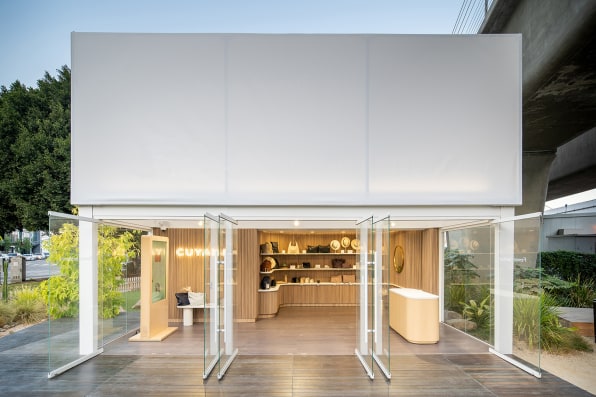
It’s a creative attempt to find new ways of injecting retail activity into vacant or underused urban spaces while also offering mostly online retailers like Cuyana a low-risk way to introduce their brand to new markets. That’s a process that can be challenging for online-first retailers. Some, like Rent the Runway, have closed all of their physical locations. For Toyota, the potential for manufacturing mobile or even drivable stores is a potential new market, especially as e-commerce and the pandemic have dealt a death blow to many traditional brick-and-mortar retail stores.
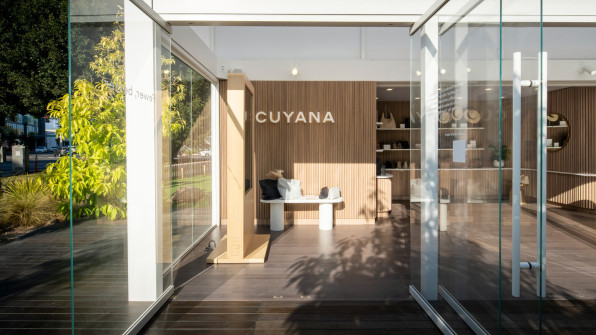
“Beyond what you might see in a typical pop-up where you’re in an existing space that doesn’t have a ton to do with what your brand is about, this design really was trying to make something special, make something that’s reflective of their brand philosophy and bring it to consumers in different places,” says Gregory Mottola, a principal in BCJ’s San Francisco office.
The structure of the store itself is relatively simple, and designed to fit on the back of standard flatbed trucks. The main forms of the store are long rectangular boxes that attach and stack together. Two of the boxes connect to each other to create a compact showroom, and a third fabric-wrapped rectangular frame rises up to create a lantern-like volume in the air, for dramatic effect. Designed to be set up within a day, the store can just as easily be detached and trucked on to its next location. The design, according to BCJ architect Lena Shah, is “more like a mobile building than a mobile vehicle.”
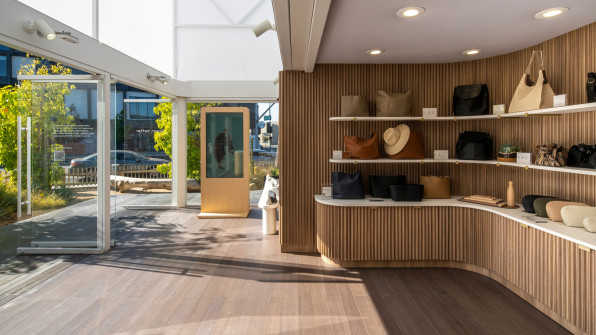
The interior of the store is heavily influenced by Cuyana, which focuses on sustainable design and natural products. The front half of the store is largely open and surrounded by floor-to-ceiling glass windows and doors, flooding the space with natural light. The back half of the store is lined with ribbed oak wall coverings, soft curves, and bronze accents, and leaves most of the floor area for customers to see and learn about Cuyana’s offerings. “They put a premium on that space where people can interact and not just try to jam it full of product,” Mottola says.
One of the three flatbed trucks it takes to move the store around carries an adaptable deck structure, helping the store site on varying topographies and also allowing easy access for pedestrians. “That’s often an issue with these pop-ups you see that are made out of shipping containers or even food trucks where you bring a mobile vehicle to a site: How do you connect it to the street or to the pedestrian experience?” Mottola says. The goal, he says, is for the store to feel like it’s part of wherever it ends up, not just a metal box dropped in a parking lot.
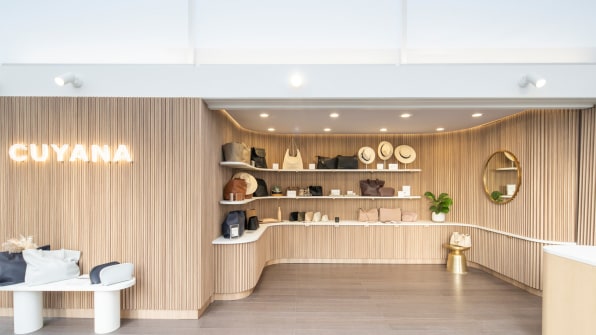
The hope, for both BCJ and Toyota, is that the mobile-store concept offers both retailers and commercial landlords a way to take advantage of underused space in cities. “How could it breathe new life into neighborhoods by bringing new retailers to town for a three- or four-month stint rather than retailers having to commit to long-term leases, which have a lot of risk to them,” Mottola says. Especially for primarily online retailers like Cuyana, the temporary mobile store offers a low-cost entry into physical retailing. “I think it totally could apply to other retailers that are trying to make that leap,” he says, noting that Toyota plans to collect data on foot traffic and lingering times within the space to better understand how the mobile stores are used by customers.
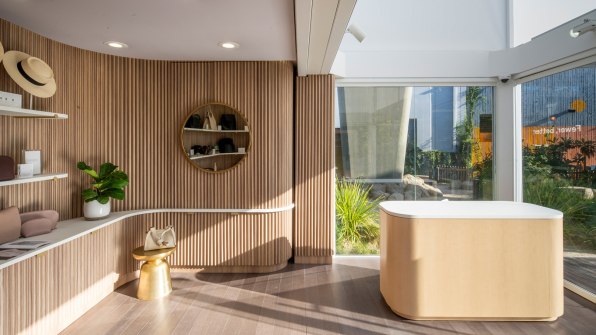
The concept can be more than just a way for online retailers to enter new markets. Shah says BCJ has explored applying the mobile-store structure for uses like temporary health clinics in underserved communities.
For now, the mobile Cuyana store will be trucked around to various locations in California, introducing the company’s high-end fashion accessories to potential customers. Whenever the experiment ends, the store can live on. BCJ intentionally designed the interior space to be easily swapped out, filling it in with a new layout and brand environment for another company. It’s a temporary store, with a temporary design, and a temporary location. But with e-commerce shaking up the dynamics of traditional retail spaces and shopping streets, this mobile store could be a way to help bring shopping back offline and into the real world.




